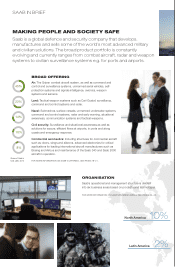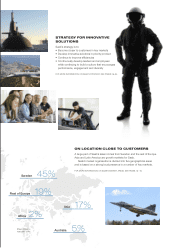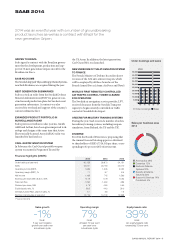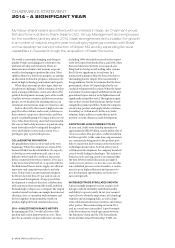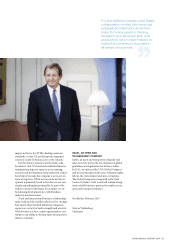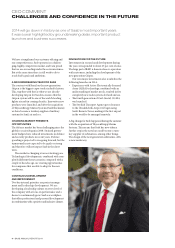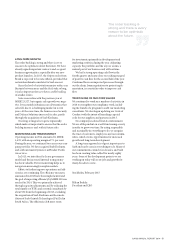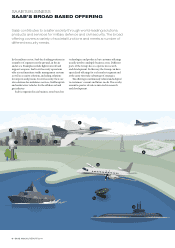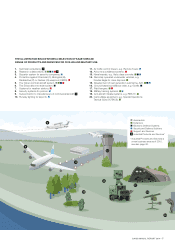Saab 2014 Annual Report Download - page 13
Download and view the complete annual report
Please find page 13 of the 2014 Saab annual report below. You can navigate through the pages in the report by either clicking on the pages listed below, or by using the keyword search tool below to find specific information within the annual report.
Aeronautics Dynamics Electronic
Defence
Systems
Security
and Defence
Solutions
Support
and Service
Combitech
REVENUE DISTRIBUTION
Saab’s sales model is divided into three main parts:
sales of products and spare parts, service assign-
ments and long-term customer contracts. In
addition, Saab generates a small share of royalties.
Long-term customer contracts account for about
60 per cent of sales, but, since Saab’s business areas
are divided by product and market oering, the
distribution diers by business area. Aeronautics is
dominated by long-term customer contracts, while
Support and Services and Combitech have a higher
share of service assignments. Due to the nature of
the revenue, sales, income, and cash ow uctuate
over the course of the year.
Long-term customer contracts comprise the
development and manufacture of complex systems.
One example is FMV’s order for the development
and modication of Gripen E, which Saab will
work on until 2026. Long-term contracts are
continually recognised in revenue, meaning that
income and expenses associated with the project
are recognised at the rate of completion of the
project. Cash ows from these contracts depend
on the timing of deliveries, advances and milestone
payments during the order period.
Service assignments consist of consulting and
support services. Examples include training and
ongoing maintenance associated with previous
deliveries. Sales from service assignments on cur-
rent account are recognised when the services are
rendered, while service assignments as part of xed-
price contracts are recognised according to the same
principles as long-term customer contracts.
e third part of Saab’s sales model is the sale of
products and spare parts that Saab manufactures
and stocks or purchases on behalf of customers.
Sales are recognised when ownership has been
transferred to the buyer. For more information,
see notes 1 and 3.
One of Saab’s aircraft mechanics working on a Gripen fighter.
20%
9%
71%
24%
21%
55%
13%
20%
67%
14%
20%
66%
7%
50%
43%
100%
As of 2015, Combitech, Aerostructures (previously in Aeronautics), Avionics Systems (previously in Electronic Defence Systems) and Saab Ventures is included in the newly formed
business area Industrial Products and Services; see page 48 as well as notes 1 and 3 for more information.
Sales distribution 2014
Sale of goods
Service assignments
Long-term customer
contracts
Service
assignments
SAAB ANNUAL REPORT 2014 – 9


